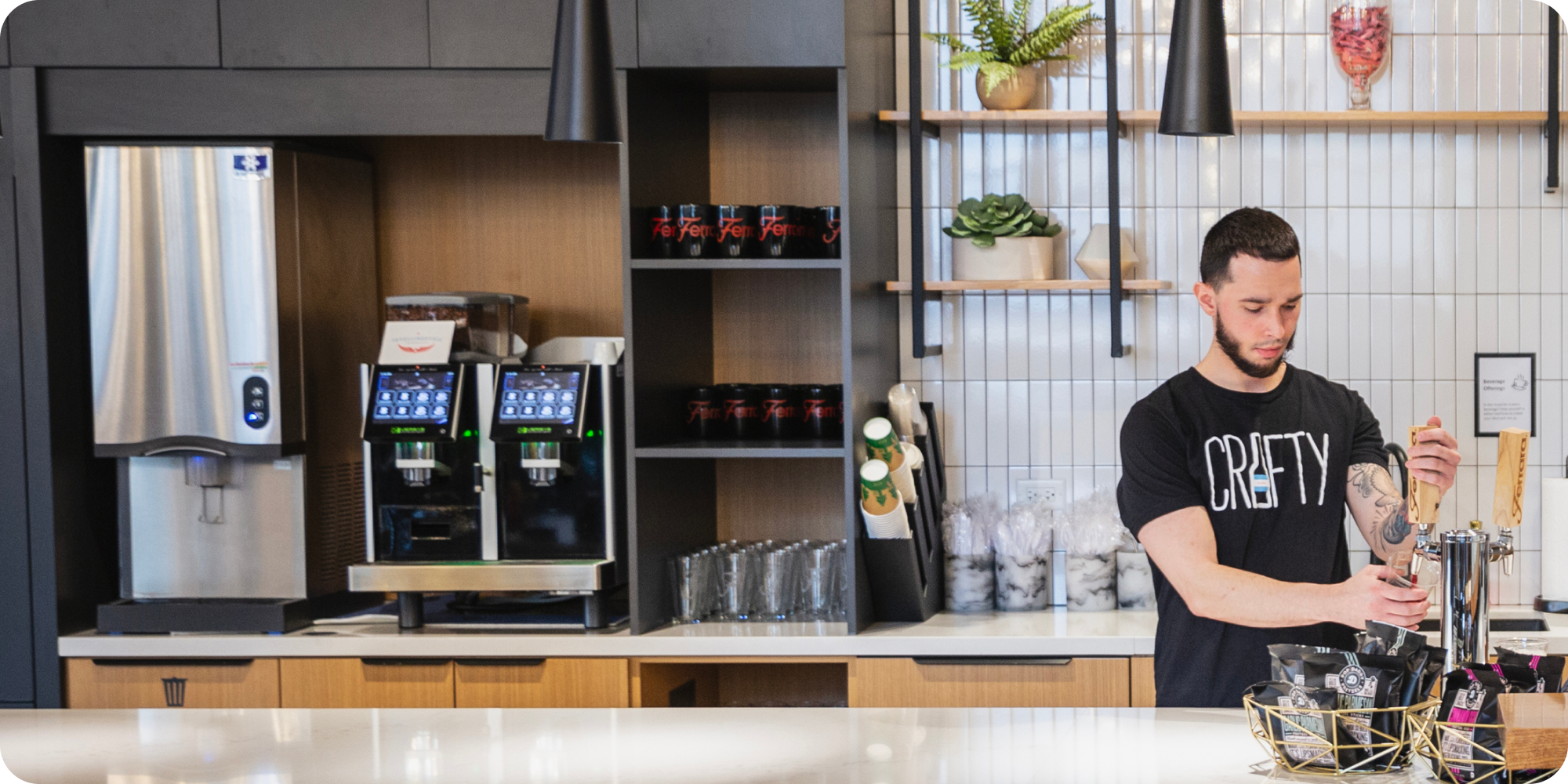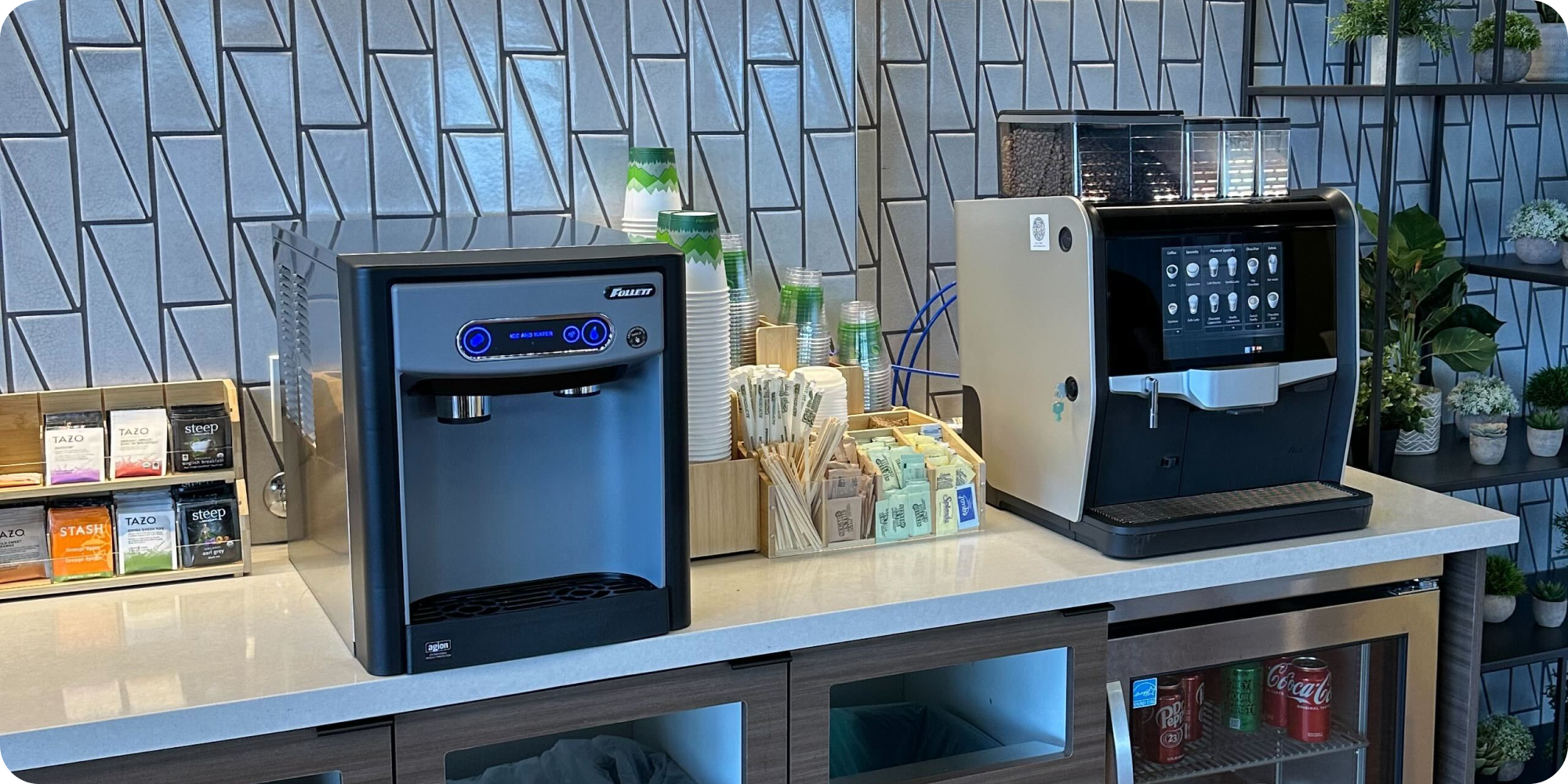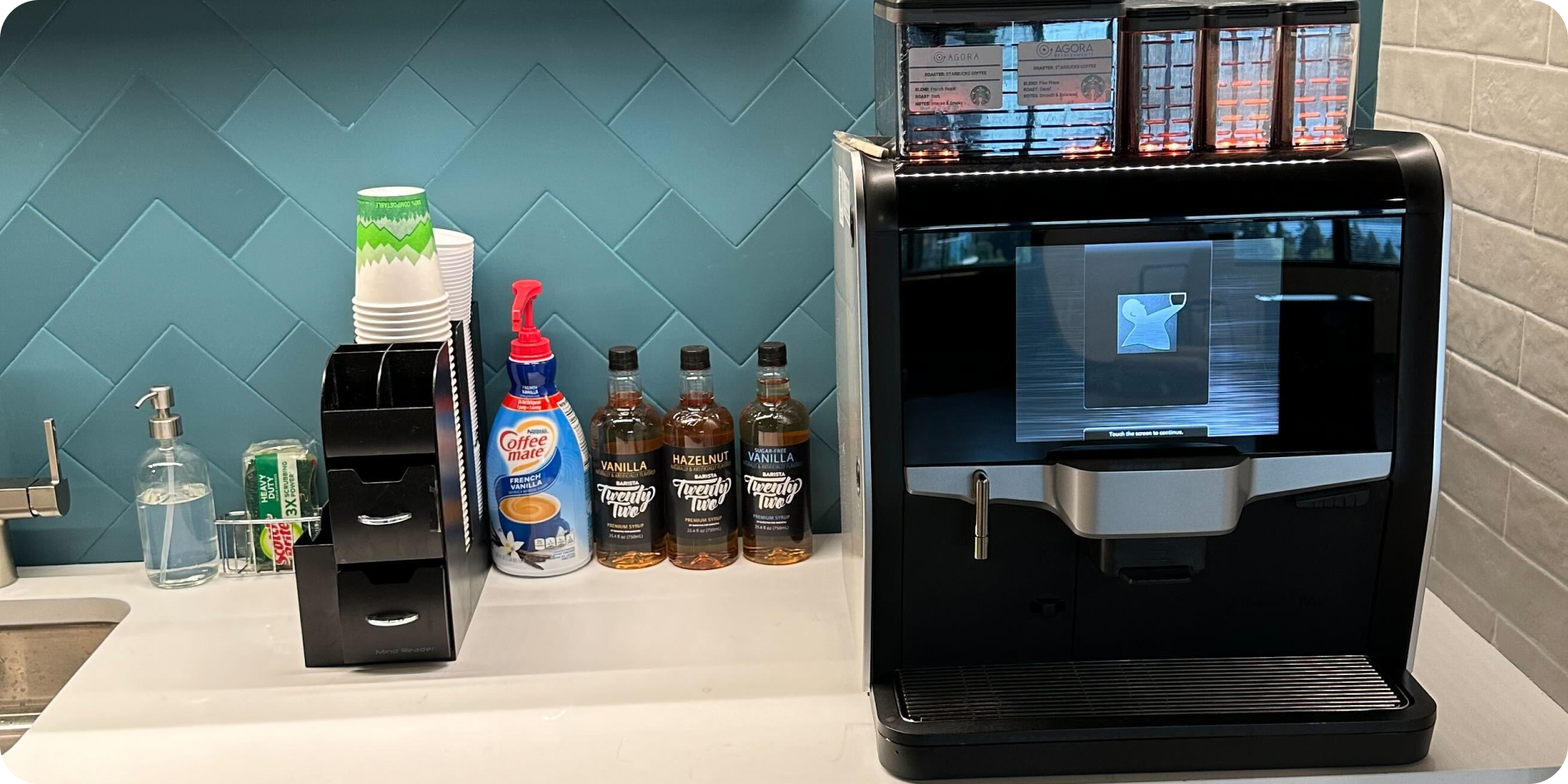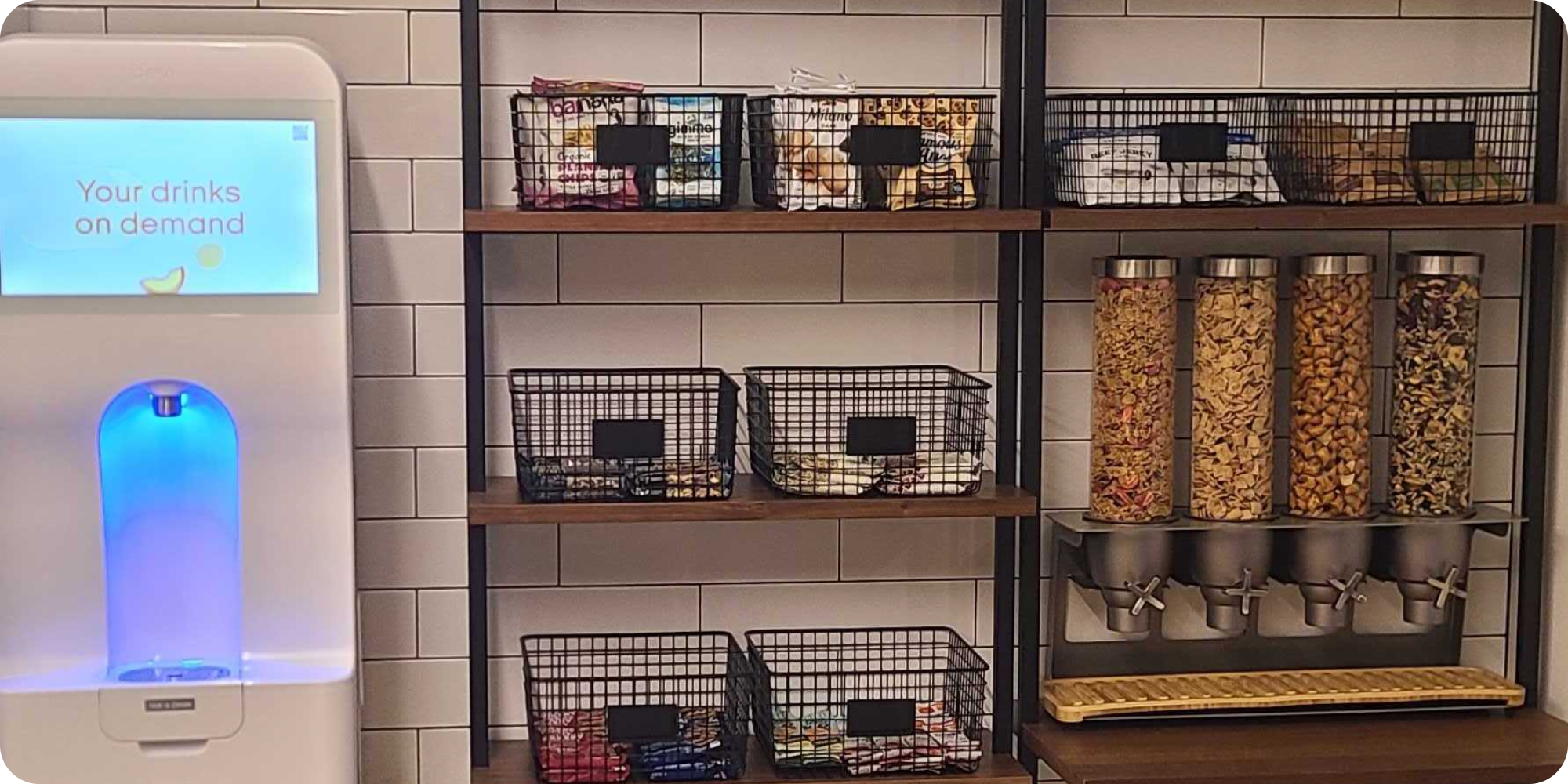Office Coffee Service 101: The Ultimate Guide
Everything you need to know to create and maintain a quality corporate coffee service.
✍️ Written by Rebecca Ross
🕚 11-Minute Read • Updated Thursday, August 21, 2025

Nobody wants their first taste of the office to be a pot of stale coffee. That’s not hospitality; that’s a caffeine crisis.
If you want people to come in, you’ve got to give them a reason—and yes, great coffee can be part of that reason. It’s one of the most cost-effective, culture-enhancing, productivity-boosting office perks. And when done right? It hits different.
"My team and I always bond over the coffee we're drinking," says Allison Cuca, Crafty's VP of Product. "It's important to have moments within the workday where I can take a break and get a good cup of coffee."
But first, let’s clear something up: there’s no one-size-fits-all when it comes to office coffee service. Maybe you just need a simple setup for your kitchenette. Maybe you're dreaming of an espresso machine, a cold brew tap, and a barista greeting people by name. The possibilities are wide—and that’s the beauty of it. The key is knowing who you’re serving, what the options are, and how you can mix and match to create a coffee experience that fits your company perfectly.
So grab your mug—this is everything you need to know about office coffee service:
- What is an office coffee service?
- Can I write off coffee for the office?
- Why do office workers drink so much coffee?
- How can I make coffee in the office?
- How do you organize an office coffee and tea station?
- What’s the best coffee maker for the office?
- How often should a coffee machine be serviced?
- What are the different coffee types?
- What coffee is best for productivity?
- Why is my office coffee so bad?
- How long does a bag of coffee last?
- Where should you store coffee beans?
- What’s the best coffee to drink in the office?
- How to improve your office coffee service?
- How to know when you need help maintaining your coffee service?
What is an office coffee service?
Let’s start with the basics—because “office coffee service” can mean a lot of things, and not all of them are good (looking at you, dusty drip pot from 2009). At its core, corporate coffee service is a workplace program that provides your team with consistent access to coffee, brewing equipment, creamers, and milk. Sometimes you'll also see tea, cold brew, or even espresso options added.
It’s more than just a caffeine fix. It’s your team’s fuel station, social hub, and daily ritual that quietly powers everything from deep focus to spontaneous brainstorms. Done right, it’s one of the simplest ways to show your employees that you care—and get some dopamine flowing while you’re at it.
Can I write off coffee for the office?
Not anymore. Starting January 1, 2026, coffee, snacks, and catered meals will no longer be tax-deductible. Under Section 112024 of the One Big Beautiful Bill, workplace and office supplies like cleaning products, cups, and paper towels will remain fully deductible.
That change makes financial visibility essential. Most office coffee vendors still lump everything into one invoice, but under the 2026 tax rules, you will need to separate deductible and non-deductible spend with precision.
Crafty makes that simple. With spend reports and category-level breakdowns, your finance team can track coffee and snack purchases separately from deductible items like supplies. No manual spreadsheet digging, no gray areas, and no tax-time headaches.
The rules have changed, but your ability to manage office coffee programs strategically has not. Invest in the culture-building perks your people love while staying compliant with the financial controls your CFO expects.

Why do office workers drink so much coffee?
Because it works.
Coffee isn’t just a beverage—it’s a ritual, a mood booster, and, let’s be honest, the MVP of workplace productivity. It’s the original “let’s power through this” tool, and there’s actual science behind it: caffeine blocks adenosine (that sleepy chemical), boosts dopamine (hello, motivation), and even sharpens memory. That’s why it’s earned permanent real estate in breakrooms everywhere.
But don’t just take our word for it—here’s what research from OnePoll found:
- 67% of employees reach for a hot cup of coffee as their very first drink of the day.
- 60% say coffee improves their mood at work (a.k.a. fewer Slack rants, more good vibes).
- 77% of coffee drinkers say they need two or more cups to feel productive on a workday.
And beyond the buzz, coffee is a connector. The coffee station is where the best convos happen. It’s where ideas percolate (yes, we said it), cross-functional teams cross paths, and people pause long enough to just… be human.
How can I make coffee in the office?
Making good coffee at work doesn’t have to be complicated. Just follow these five steps:
- Know your team: Drip? Cold brew? Oat milk everything? Start with what your people actually drink.
- Pick the right equipment: Match your setup to your space, headcount, and speed needs—no one likes a morning line.
- Choose better beans: Quality matters. Go for fresh, well-sourced, and the roast levels your team loves.
- Stock the good stuff: Dairy and plant-based milk, flavored creamers—options matter more than you think.
- Sweeten the deal: Syrups, honey, sugar, stevia. Little details, a big upgrade.

How do you organize an office coffee and tea station?
We’ve seen a lot of coffee setups in our day—and let’s just say there’s a big difference between a thoughtfully organized station and a chaotic corner. A well-designed coffee and tea station does more than serve caffeine—it sets the tone for your whole office experience.
Here’s how to organize your coffee station like a pro:
- Location is Everything: Your coffee station should be accessible, but not in the middle of the office’s main walkway. Aim for a central spot that feels intentional—close to the kitchen or break area, but with enough room for people to linger without causing a traffic jam. Bonus points for natural light and a few comfy chairs nearby to encourage coffee breaks and casual chats.
- Zones Make It Easy: Break your station into clear zones:
- Supply Zone: Stack cups, lids, and napkins near the machine, not across the room. Include compost bins or trash cans to keep things tidy.
- Brew Zone: Machines (drip, pod, bean-to-cup, hot water) with enough counter space to operate comfortably.
- Mixing Zone: A neat setup for creamers, sweeteners, syrups, stirrers, and alt milks. If you have milk or alternatives in a fridge, make sure it's close by but not too close.
- Tea Zone: Group your teas by category (herbal, green, black) and keep them in clear dispensers or boxes for easy access.
- Visibility Drives Use: Make it easy for people to see what’s available. Easy-to-see storage, labeled beans and mix-ins, and neatly stacked tea tins make the station look better and help people move through the space efficiently.
- Keep It Clean, Always: Coffee spills happen. So do sugar crystals and tea bag drips. Equip your station with visible cleaning essentials to encourage employees to clean up after themselves.
What’s the best coffee maker for the office?
The best brew method depends on your team size, preferences, and how much time people have between meetings. Here’s a quick guide to help you choose the right setup—or mix a few for full coverage:
- Drip Brewers: Reliable and efficient—great for high-volume needs like larger teams or all-hands meetings. Brews full pots quickly and keeps the line moving.
- Pod Machines: Fast and flexible—perfect for smaller offices or teams with lots of individual preferences. Just pop in a pod and go.
- Bean-to-Cup Machines: Fresh-ground flavor with the push of a button—offers café-level quality without needing a barista. Great for mid-to-large teams who value quality.
- Cold Brew Keg: A crowd favorite—smooth, high-caffeine, and refreshing, especially in warmer months or wellness-focused offices.
- Espresso Machines: Best for high-touch environments—ideal in executive suites or hospitality-driven spaces. Great for lattes, cappuccinos, and custom drinks.
Pro tip: Many offices combine multiple methods (like drip + single-serve + cold brew tap) to meet a range of needs without overwhelming the space or the budget.
How often should a coffee machine be serviced?
Short answer? More often than you think.
Your office coffee machine isn’t just brewing a few morning cups—it’s likely powering 50+ people, multiple times a day. That kind of traffic requires regular TLC to keep things running smoothly and tasting great.
Here’s how we break it down:
Daily:
- Wipe down external surfaces and buttons
- Rinse brew baskets, drip trays, and carafes
- Empty and clean milk containers and water tanks
- Keep the surrounding area clean (no rogue grounds, no sticky counters)
Weekly:
- Lightly clean internal components to prevent oil and residue buildup
- Sanitize cold brew or milk systems
- Check the grinder for clogs and ensure consistent grind size
- Remove and rinse detachable parts
Monthly to Quarterly:
- Descale machines to prevent mineral and limescale buildup
- Replace water filters to maintain water quality and flavor
- Monitor brewing temperature and pressure for consistency
- Perform deeper internal cleanings based on machine usage
Annually:
- Deep cleaning of the machine
- Review equipment performance and plan for upgrades or replacements

What are the different coffee types?
Not all coffee is created equal—and offering a variety isn’t just about preference, it’s about experience. Each roast and format has its own flavor profile, caffeine level, and ideal moment in the day. Here’s a quick rundown to help you build a well-rounded coffee lineup:
- Light Roast: Bright, citrusy, and high in caffeine—great for morning energy and lighter flavor lovers.
- Medium Roast: Smooth, balanced, and versatile—your classic crowd-pleaser.
- Dark Roast: Bold, smoky, and lower in caffeine—perfect for traditional coffee drinkers.
- Espresso: Intense and concentrated—rich flavor, ideal for quick shots or specialty drinks.
- Cold Brew: Smooth and subtly sweet—low acidity with a strong caffeine kick.
- Nitro Cold Brew: Cold brew infused with nitrogen—creamy, fizzy texture with a bold finish.
A little variety goes a long way in keeping your team happy (and caffeinated).
What coffee is best for productivity?
Let’s talk caffeine—because when it comes to staying sharp at work, not all coffee is created equal. The trick isn’t just drinking more coffee; it’s drinking the right kind.
Here’s the quick science: Caffeine levels vary based on bean type, roast level, and brewing method. Lighter roasts actually have more caffeine than darker roasts (yep, really), and brew time and water contact matter too. The goal? Maximize focus without the crash.
So what’s best for a productive workday? Here’s your coffee lineup, ranked from most to least caffeine:
- Cold Brew: Brewed slowly over time, this powerhouse packs the most caffeine per ounce (thanks to a long extraction process). It’s smooth, less acidic, and gives a steady lift without the jitters.
- Light Roast Coffee: More caffeine than dark roasts, with bright, mood-boosting flavor notes like citrus or berry. Great for starting the day strong.
- Medium Roast Coffee: Balanced flavor and caffeine. A solid, all-day option for focus without overload.
- Espresso: Small but mighty. While it has less caffeine per serving than drip or cold brew, it’s highly concentrated and great for a quick boost.
- Dark Roast: Lower in caffeine than lighter roasts, but preferred by folks who love that bold, smoky flavor. Best as a comforting afternoon cup.
- Decaf: For when it’s all about ritual, not energy. (And yes, there’s still a tiny bit of caffeine in there.)
Why is my office coffee so bad?
We’ve all been there: watery drip, stale beans, mysterious aftertaste. Bad office coffee usually comes down to these three culprits:
- Old beans: Coffee can technically last a while, but freshness fades fast when it’s not stored properly. If beans are left open in a warm, humid, or bright spot, they’ll go stale quickly—leaving you with a flat, lifeless cup.
- Poor equipment maintenance: Coffee equipment needs regular upkeep. Old filters, mineral buildup, and leftover oils can all affect the taste. Without consistent cleaning, even great beans won’t stand a chance.
- Misaligned coffee preferences: You could have the highest-quality dark roast on the planet—but if your team prefers light roast or cold brew coffee, it’s not going to land. Great coffee service isn’t just about premium coffee; it’s about offering the right options for your people.
How long does a bag of coffee last?
Whole coffee beans stay fresh for about 6 months to a year if stored properly. Ground coffee? About 1–3 months in the pantry or up to a year in the freezer.
Which leads us to…
Where should you store coffee beans?
Office kitchens aren’t exactly known for climate control, but proper storage makes a big difference in flavor. To keep your beans fresh and your coffee tasting great, store them in a cool and dark place. Keep it away from any heat sources—yes, that includes the cabinet above the microwave.
Skip the fridge or freezer (moisture is the enemy), and avoid leaving open bags on the counter. If you’re ordering in bulk, only open what you need and keep the rest sealed until it's time to refill. Better storage = better brews, every time.

What’s the best coffee to drink in the office?
The best office coffee isn’t about chasing what's new—it’s about knowing your people. Some teams love bold and chocolatey blends, while others are all about light roast, oat milk, and nitro on tap. The key is stocking what gets used (and loved).
At Crafty, we track consumption across offices nationwide so we can tailor your setup to real preferences—not guesses.
Top Picks From Crafty-Powered Offices:
- Counter Culture Hologram: Smooth, chocolatey, and a total crowd-pleaser
- Big Shoulders – Bold Slugger: A bold, dark-roast Brazilian blend with a creamy body and subtle fruit notes.
- Rise Brewing Co. Nitro Cold Brew (Canned): Creamy, dairy-free, and ready to drink—great for latte lovers who want that café feel without the equipment.
📍Want to see what offices are drinking in your city?
Check out the most popular office coffees by city >
How to improve your office coffee service?
Improving your office coffee setup isn’t just about buying fancier beans—it’s about being intentional, cost-aware, and experience-focused. When your coffee service is built around how your team consumes coffee (and how often), you’ll see better satisfaction and smarter spending. Here’s how to take your office coffee game to the next level:
- Budget Smart: Estimate the cost per person per day based on how your team drinks coffee—morning drip, mid-day cold brew, afternoon espresso. Once you visualize those habits, you can build a budget-friendly pantry program that delivers those cost-effectively.
- Know Your Data: Guessing what’s getting used leads to waste. You need to be able to track what’s popular, know what’s sitting untouched, and detail out where your dollars are going.
- Use Merchandising to Your Advantage: Yes, even coffee needs good merchandising. How you display your coffee setup impacts how it gets consumed—and how much you spend. Position your cost-effective items at eye level to drive volume, while keeping premium options available but slightly less front-and-center.
How to know when you need help maintaining your coffee service?
Keeping your office coffee station running smoothly by yourself gives you control, but it also means that all the responsibility is on you. You’re sourcing beans, buying pods, refilling syrups, deep cleaning machines, and handling the dreaded inventory spreadsheets. It works for smaller teams or single locations, but it can get messy fast—especially when your CFO starts asking for year-end reporting on coffee spend.
It may be time to bring in reinforcements. A partner like Crafty can take this off your plate. We handle everything from sourcing and delivering your coffee and tea products to keeping equipment clean, stocked, and running smoothly. Whether it’s managing inventory, restocking beans, troubleshooting machines, or keeping your station organized and inviting, Crafty does the heavy lifting—so all you have to do is enjoy the coffee.
And with the Crafty Platform, you stay in control without needing to be physically onsite. It gives you full visibility into what’s being consumed, what’s driving cost, and what’s going to waste—so you can make smart, data-backed decisions from anywhere.
Conclusion
Office coffee service isn’t just about caffeine—it’s about creating a daily experience your team looks forward to. Whether you’re running a simple drip setup or curating a full espresso bar, great coffee shows your people that you care, fuels real productivity, and builds culture in the moments between meetings. With the right products, a smart setup, and a partner like Crafty behind the scenes, it’s easy to turn your breakroom into something that works for your workplace.
So the real question is: what would happen if you just called Crafty?
Explore the Craftyverse
CRAFT
A BETTER
WORKPLACE
Elevate your office food and beverage program with enhanced services managed in one innovative, centralized platform.


![Crafty strategies of employee engagement ebook [2025] Crafty strategies of employee engagement ebook [2025]](https://info.craftydelivers.com/hubfs/Crafty%20strategies%20of%20employee%20engagement%20ebook%20%5B2025%5D.png)